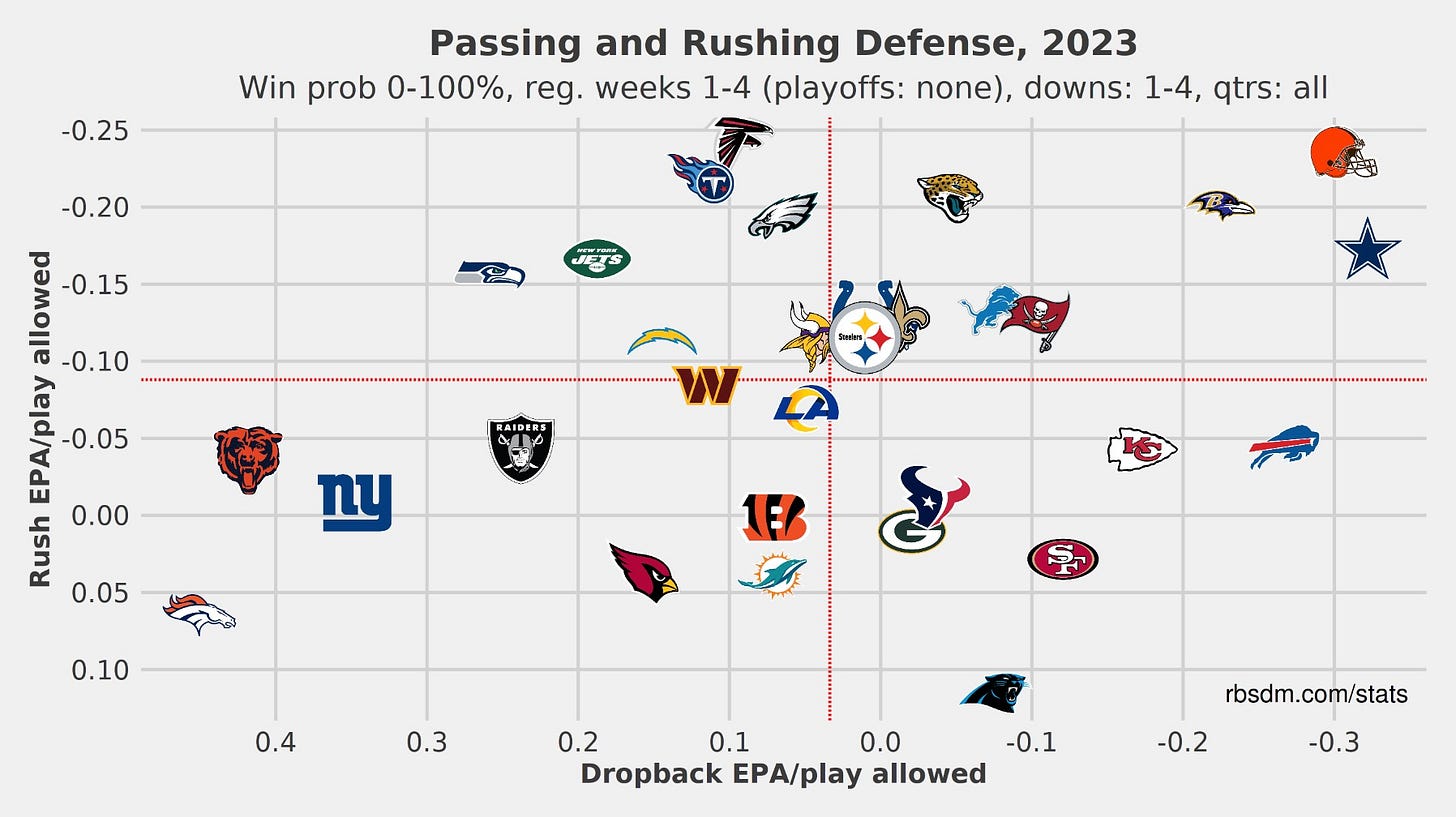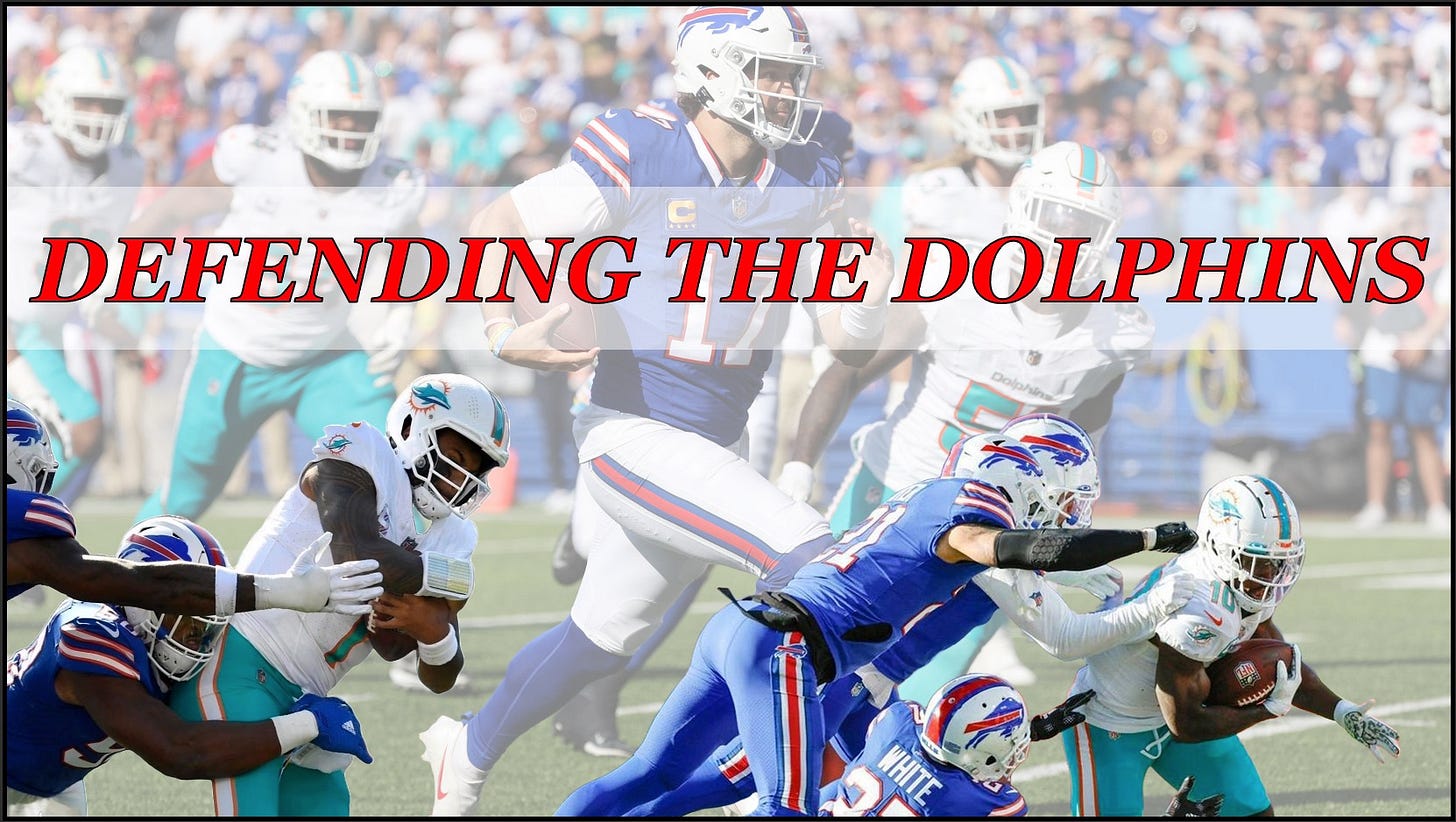Defeating the Dolphins: Bills Edition
I take a look at how the Buffalo Bills were able to stop what looked to be an unstoppable force in the 2023 Miami offense (Week 4)
The Bills did the seemingly impossible on Sunday. Not only did they defeat the Dolphins, who were coming off a weekend where they scored 70 points, but they did it strikingly. Buffalo was also down a Safety in Jordan Pryor. All signs pointed to a classic shootout between two of the best offensive units in the NFL. The Bills had other plans.
Through four weeks, the Bills sit at #2 in Total DVOA (behind the Cowboys) and hold the second-best passing DVOA (also behind Dallas), according to FTN. EPA also shows the Bills have one of the best defenses in the NFL after a quarter of the season is complete. Below is a chart from RBSDM that shows where each defense lines up after taking into effect their Rush and Pass EPAs.

One of the reasons the Bills were able to succeed against the Dolphins is their defensive line. Even without Von Miller, Buffalo has a formidable rotation with four former 1st-round draft picks (five if you include Miller). Inside, DaQuan Jones holds the best iDL Pass Rush Win Rate (PRWR) through the season’s first four weeks. Ed Oliver also clocked in at 14th overall.
When a defense can relegate four defenders to occupy the O-line, it allows the defense an extra man in coverage. The Bills have athletic pieces in their LB corp as well. Mike Milano and Terrel Bernard are a speedy duo that can cover TEs, RBs, and the occasional Slot WR. Playing the Dolphins, who have assembled a track team on offense, requires a defense to be fast.
Mike McDaniel and the Dolphins have created a modern iteration of the natural cycle we see in football. Miami uses 21 pers. to force defenses to make a choice. Go ‘big,’ and they will run around your lumbering defenders. Go ‘light,’ and they will run through your DBs. The offense spreads a defense thin, utilizing every inch of the field.
The Bills, though, are used to playing in their Nickel package. Through four weeks, Buffalo is the only team in the NFL with over 90% Ni usage (99.1%). They only have two snaps of a ‘base’ 4-3 against the Raiders’ 22T package (two TEs, one being an extra Tackle + a FB).
With talent up front, Buffalo can allocate numbers in the backend. Below is an example of how, even when the Dolphins ran the ball, the ILBs could stay clean and run to the ball. When a defense can control five or more with just four D-linemen, it usually spells success.
It is simple math. If the Bills can use their four D-linemen to occupy the five O-linemen, they can use seven defenders in coverage. The offense can only send out five receivers, so the defense ends up with a net +2. If the D-line can cause issues up front, forcing the offense to leave a TE or RB in protection, that number can move to a net +3 (7 - 4 = +3).
Buffalo manufactures pressure through their front four. According to PFF, through Week 4, the Bills sit 4th lowest in Blitz Rate at 19.6%. Instead of using pressure, Head Coach Sean McDermott lets his D-line control the front. Combined with how well the Bills’ offense played, the Dolphins never had a chance to get their offense going. Once Buffalo pulled away, Miami was forced to throw the ball.
Against the Dolphins, who have a quick operation time within their passing game, it was imperative the Bills hit home when Miami passed and controlled the line of scrimmage (LOS) when the Dolphins ran the ball. When facing a team like Miami’s, there is a tendency to get passive or completely change the scheme of a defense. McDermott and his defensive staff stayed the course regarding pressure philosophy. Looking at their three previous opponents, the blitz rates all look similar.
A powerful platform used on Microsoft® Visio & PowerPoint to allow football coaches to organize, format, and export Playbooks, Scout Cards, and Presentations efficiently.
Keep reading with a 7-day free trial
Subscribe to MatchQuarters by Cody Alexander to keep reading this post and get 7 days of free access to the full post archives.



